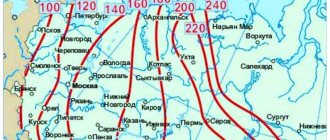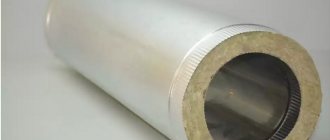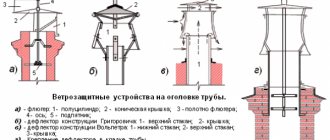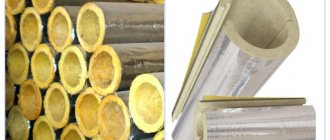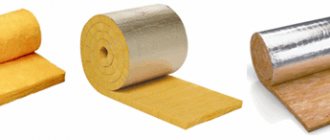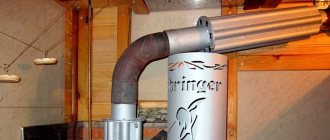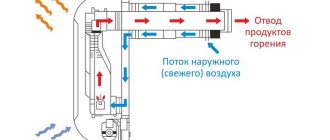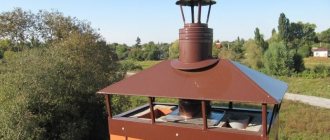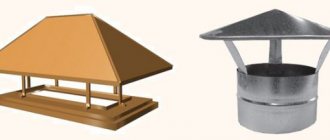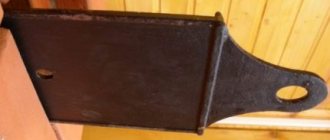When installing a fireplace or stove in a private house or country house, the question often arises of how and with what to insulate a metal chimney pipe with your own hands. Properly performed chimney insulation is important from the point of view of fire safety and roof protection from leaks. It is advisable to think about the scheme according to which the chimney will be insulated, even at the design stage of the building. Insulating an already completed chimney system is not always possible without changing the roof structure.
It is necessary to insulate the chimney; there are many methods and materials for this.
Why do you need to insulate a chimney?
During operation, a large amount of combustion products and hot air is transported through the smoke channel. All this reduces the service life of the chimney due to the acceleration of corrosion processes and oxidation of the internal walls of the outlet channel.
Among the most common problems that lead to damage to the chimney are:
- presence of moisture - increased pressure and constant humidity are observed in the chimney pipe. Due to the temperature difference inside and outside the chimney, moisture partially condenses on the walls of the duct, which ultimately has a detrimental effect on the operational condition of the metal;
In the absence of thermal insulation, a large amount of condensate accumulates in the chimney
- chemical environment - the combustion of solid or liquid fuel produces a large amount of aggressive substances that are hazardous to human health. When the chimney operates correctly, all formed substances are removed outside under the influence of natural draft. When the draft level decreases or when the chimney is not functioning, substances accumulate on the walls of the smoke channel, which leads to slow but progressive destruction of the chimney pipe.
Insulating the chimney using modern thermal insulation materials reduces the risk of damage and reduces the rate of corrosion processes. For example, insulating steel chimneys extends the service life of the product by 2 or more times.
Advantages of an insulated chimney
Timely thermal insulation of the chimney reduces the risk of exposure to factors leading to damage in metal, brick or ceramics. With the correct thickness of insulation, the problem with condensation is solved almost completely - the dew point moves to a section of the pipe located above the roof level. This significantly increases the resource of the smoke duct and the service life of the smoke duct system as a whole.
Insulating the chimney increases its service life several times
Other advantages of an insulated chimney include:
- Reducing the level of deposits - thermal insulation materials help reduce the temperature difference between combustion products and the surface of the chimney. This reduces the amount of substances deposited on the inner surface of the chimney.
- Energy saving - during operation, an insulated chimney takes in less energy obtained from burning fuel. This allows you to reduce fuel consumption and energy spent on maintaining a constant temperature in the combustion chamber.
- Strength and stability - Thermal insulation installed around the chimney acts as a frame and increases the strength and stability of the structure. This is especially noticeable when installing thin-walled metal chimneys.
Modern insulation materials increase the frost resistance of the smoke exhaust system. If the insulation technology is followed, it is possible to reduce or completely eliminate the impact of high temperature in the area where the pipe exits through the roof.
Other methods of insulating water supply pipes
Pipeline insulation can be done not only with the help of insulation. For this purpose there is a heating cable, as well as the possibility of deepening communications below the soil freezing line
Burying pipes below the soil freezing line
Laying them half a meter below the freezing depth of the soil helps prevent damage to pipes in winter. You can find out its exact value in the reference tables. They contain data for all regions of the country. This option seems to be the simplest for insulating the water supply, but does not completely solve the problem. Even if the quality of the soil and the depth of groundwater allow deep burying of pipes, their open areas will remain at the entrance to the house. They need to provide additional insulation.
In order not to overpay for thermal insulation of an underground water supply system, you need to correlate:
- costs for any other method of insulating pipes along their entire length;
- costs for digging a trench and additional insulation.
After calculations, the most profitable option is selected.
Please note: the depth of soil freezing in some northern regions reaches 2.5 m
Application of heating cable
The heating cable, which carries electric current, can be installed inside and outside water pipes. It is placed inside through a special tee, and outside is most often wound in a spiral. The cable inserted into the pipe must have a moisture protection rating of IP68 and not emit harmful substances.
When using cable, the pipes are additionally insulated. This reduces electricity costs and reduces the load on the network. Rigid thermal insulation is recommended for underground pipelines. You can find resistive and self-regulating heating cables on sale. The first option is inconvenient to work with (cannot be cut), requires the mandatory installation of a thermostat and verified calculations for the insulation of communications.
The second option is preferable for the following reasons:
- economical;
- protected from overheating even when laid overlapping;
- can be cut;
- service life up to 15 years.
The main disadvantage of a self-regulating cable is its high price. Such expenses, taking into account additional insulation, are not always affordable.
Insulation materials for thermal insulation of chimneys
To insulate a stove chimney, materials are used that provide a high degree of insulation coupled with low thermal conductivity. This eliminates the risk of “cold bridges”, icing and condensation.
Among the most effective and popular materials for insulation are the following:
- plaster - used for insulation of brick and stone chimneys. The plaster solution is applied to a previously prepared reinforced surface. In terms of labor costs and quality, this method is the least justified;
Insulating a chimney with heat-resistant plaster requires unreasonably large amounts of labor
- broken brick - used for thermal insulation of brick and steel structures. The material is poured into a casing, which is secured around the chimney. The minimum distance from the chimney is 60 mm. Sometimes slag is used instead of broken brick;
Screened slag tightly fills the installation gap and provides a high degree of thermal insulation of the chimney
- basalt wool is a modern thermal insulation material produced in the form of mats or cylinders with different internal cross-sections. The material is wrapped around the chimney and secured with steel crimp clamps. In terms of price and quality ratio, this method is the most effective.
In fact, all the methods described above have some similarities - the insulation is applied or fixed to the outer surface of the chimney. After which the heat-insulating material is protected by a steel casing.
To save money, the outer steel pipe can be replaced with wood or cinder concrete slabs. For example, you can fasten a rectangular frame around the chimney using wooden boards at hand, and fill the space between the pipe and the boards with any heat-insulating material.
Which insulation is better to choose
The first thing to remember when choosing a material for chimney insulation is that the thermal insulation must be made of non-combustible components. During operation of the chimney, the insulation will heat up to 100–150 °C, and at the point where the pipe exits through the ceilings, the temperature can be even higher.
If the installation of insulation will be carried out by one person, then it is better to choose the lightest and most solid material. Otherwise, problems will certainly arise during insulation, which will ultimately affect the quality of the work performed.
To insulate a chimney yourself, it is better to use basalt thermal insulation. The shape and thickness of the product is selected taking into account the existing chimney structure.
The basalt cylinder can be selected exactly to the size of the chimney pipe
The advantages of insulation based on basalt wool include:
- high thermal insulation qualities;
- good vapor permeability;
- resistance to chemicals;
- immunity to the formation of fungus and mold;
- high heat resistance when heated above 100 °C;
- environmental friendliness and safety.
Before using ready-made thermal insulation from the manufacturer, you should carefully study its installation technology. As a rule, high-quality products are equipped with a paper insert or instructions that describe in detail the method of cutting and installation.
Video: basalt wool flammability test
Selection of material for thermal insulation
There is no particular difference between insulating the chimney in the house or insulating the chimney in the bathhouse. The choice of insulation must be approached extremely responsibly and under no circumstances should you purchase cheap materials that will not last the required period. The main requirements for insulation must be based on two factors:
- non-flammable;
- non-toxic.
Mineral wool
The choice can be made from basalt, stone or mineral wool (glass wool). Due to their characteristics, these types of insulation can withstand quite serious temperature changes; in addition, such material can withstand even direct exposure to fire. In addition, the presence of pores allows you to retain heat.
There are also so-called multifunctional types of insulation - teploizol and folgoizol. They are excellent for insulating a chimney in a bathhouse, since the temperature there rarely exceeds 150-200 degrees.
Basalt insulation
Given its spread and popularity, we need to talk a little more about it. So, as already mentioned, it tolerates high temperatures and even direct exposure to fire. Therefore, it is possible to “cover” and insulate the channel along its entire length, even at the junction with the heat source. In addition, for a chimney on the roof, the use of such wool is simply necessary, because it is recommended to make a thermal “layer” between the ceilings from it. After all, it is non-flammable and is perfect for a chimney.
Basalt thermal insulation shell for chimneys
However, despite such wide possibilities and positive aspects, it also has disadvantages:
- There is no sufficient tightness, and all because of the presence of technological seams.
- High price.
- Harm to health during installation may result if you tear off a piece of the material and gut it; the resulting dust will not have a positive effect on the respiratory tract.
- The ability to pass steam does not allow its use in some cases.
Stainless steel casing
The casing parts are fastened together using self-tapping screws. The casing itself should be formed from metal profiles; if you use metal sheets, then in principle you can take wood, but judging from experience, it is better to install a base from profiles.
Pipe insulation using stone wool and metal sheet
To make a box in the ceiling, you need to use a stainless steel sheet. Four identical U-shaped sheets of metal with prepared holes are cut out of it. They are connected to each other using self-tapping screws and screwed to the ceiling. After this, you need to prepare the bottom for this casing; use a similar material for it. A square is cut according to the dimensions, and a hole is made in it for a pipe of the required diameter. After this, we fasten the bottom, insert the pipe and lay insulation.
Wooden shields
For this kind of work on thermal insulation of chimney pipes, wood can also be used. Often they take wooden blocks as a basis, which are sheathed with OSB panels. Also, after installing the pipe in a specially cut hole, the voids are filled with insulation.
Shields made of wood and metal, expanded clay inside
Slag-reinforced concrete insulation slabs
The specifics of concrete slabs have some differences, namely, the use of cotton wool in this case is not recommended. You can insulate using bricks or tiles. In the absence of bricks, you can use glass wool for a slag concrete slab. Also, do not forget about the finishing features; in this case, it is even recommended to use special solutions that can insulate just as well and are resistant to temperature changes.
Construction of a steel insulated chimney
An insulated chimney is a “pipe-in-pipe” design, similar to a sandwich pipe, which is also used for the construction of smoke channels. Typically, the external pipe is a wooden box lined with asbestos boards or a large-diameter steel pipe.
Any insulated chimney consists of a smoke exhaust duct, an outer shell and a layer of insulation between them
Between the outer shell and the chimney there is a non-flammable thermal insulation material, secured mechanically or glued with heat-resistant glue or sealant. The inside of an insulated chimney is nothing more than a chimney .
The layer of material used as insulation acts as a thermal insulation barrier. On the one hand, it prevents the elements in direct contact with the chimney from heating up. On the other hand, cold air does not cool the chimney and thus does not create a sharp difference between the temperature of the exiting combustion products and the inner surface of the pipe.
Installation of cylinder insulation for pipes
There are no general instructions for installing thermal insulation of pipes in the form of cylindrical casings. Each material has its own operating characteristics. In this case, a number of general rules can be identified. They are enshrined in the current SNiP 2.04.14-88 “Thermal insulation of equipment and pipelines”.
General rules and recommendations for work
Laying cylinder insulation on water pipes can be done both before and after their assembly. However, experts insist on the second option, since the water supply system needs to be checked for leaks.
Please note: the insulation is simply put on top of individual pipes, like a cover. If the pipeline is assembled, a longitudinal cut is made on the thermal insulation segments and the communications are wrapped with them
If the pipes are old, they are cleaned of dirt and rust, and then coated with anti-corrosion compounds. The cylindrical segments are selected and placed close to the communications. They should not hang out, leaving an air gap. Fastening the insulation begins from the flange connections so that the seams do not form a straight line (staggered seam).
The insulation is fixed with bandages made of aluminum strips or painted packaging tape. An alternative to them is stainless steel wire with a diameter of at least 2 mm. For hard casings, heat-resistant glue or mastic is used. To insulate bends and tees, appropriate insulating elements (shaped) are sold. They can also be cut from the main segments using a miter box. All joints are insulated and secured with clamps.
Features of installation of some materials
When laying foam shells on large-diameter pipes, you may need not two half-cylinders, but a larger number of segments. In this case, additional insulation and fixation of the casing is provided. To do this you can do the following:
- glue the joints of the segments with foil tape;
- add clamps along the length of the pipeline;
- glue the locking connection of the segments.
Additional protection for cylinder thermal insulation made of polystyrene foam is its wrapping with polyethylene.
To work with foam rubber (for example, K-FLEX) you will need a special glue. It is applied with a stiff short-haired brush in an even layer. Then the insulation is pressed tightly against the pipe without stretching. The water supply system must be turned off. Water supply begins no earlier than 36 hours after completion of work.
Calculation of materials and design parameters
Before purchasing the insulation and materials necessary to assemble the frame around the chimney structure, you will need to calculate them. This will save money, especially if specialized expensive products are used for insulation.
Before making calculations you will need to measure:
- external section of the chimney;
- length and width (diameter) of the chimney;
- height of the pipe from the inlet pipe.
The data obtained allows us to calculate the required amount of thermal insulation material and additional accessories. As an example, we will calculate the materials for insulating a steel chimney with a cross-section of 200 mm and a height of 5 m.
For thermal insulation of round-shaped chimneys, ready-made cylindrical fragments of insulation are produced
When using a basalt “shell”, products with a total length of 5 linear meters with an internal cylinder diameter of 210 mm will be required. Insulation density is 120–150 kg/m3. The thickness of the heat insulator is selected taking into account the temperature conditions in the region. For operation in Russian winter conditions, cylinders with a thickness of 70–100 mm are sufficient. As an external pipe, you will need a galvanized steel product with a cross-section of 280–310 mm and a total length of 5 m.
To insulate square-shaped chimneys, it is convenient to use basalt wool in slabs
To insulate chimneys of square or rectangular cross-section, you will need to know their dimensions. For example, a square chimney with a side of 0.3 m will require (0.3 * 5) * 4 = 6 m2 of insulation. We still assume the length of the chimney to be 5 m.
If you buy high-quality insulation, then usually one package contains a roll with a total area of 5 m2. This means that for our example we will need two packages of basalt wool in rolls. Roll parameters - 5000x1000x50 mm. To assemble a frame around a square chimney, you can use a 50x50 mm block. An asbestos board 3000x1500x12 is better suited for external cladding.
Required tools and supplies
In addition to insulation, additional consumables are required for thermal insulation work. Galvanized self-tapping screws 30 mm long are used to assemble the wooden frame and its cladding. To fix the heat insulator, a fireproof sealant is used - Penosil High Temp, PENOSIL Premium 1500 or MAKROFLEX HA147.
A heat-resistant sealant is used to fix the insulation to the surface of the chimney.
To insulate chimneys made of steel or ceramics you will need:
- metal scissors;
- construction knife;
- screwdriver;
- angle grinder;
- Screwdriver Set;
- safety glasses and gloves;
- tape measure and pencil.
To plaster a chimney, you need to prepare a container for plaster, a plaster trowel, a wooden rectangular float, a triangular float, a rule and a long-haired paint brush.
Do-it-yourself insulation - procedure
Before you start installing thermal insulation, prepare everything you need for work. Clean the pipe from dust, repair cracks and chips. It is important that the surface is dry, otherwise the quality of thermal insulation will decrease.
Plastering
- The mixture is mixed with water using a construction mixer in the proportions specified by the manufacturer. It is better to first pour water into the container and then add the dry mixture.
- Using a spatula or trowel, the solution is applied in spots over the entire surface of the pipe and leveled.
The plaster solution is leveled over the entire surface of the pipe - The pipe is covered with a reinforcing mesh along the spots of the solution, which will secure it to the surface. The mesh is necessary to strengthen the plaster layer; it plays the role of a frame.
- The first layer of plaster is applied on top of the reinforcing mesh. It is important that it covers the entire surface without gaps.
In order for the layer of plaster to adhere to the surface of the chimney, a reinforcing mesh is used - The plaster is leveled and left to dry.
- After this, several more layers are applied, each of which needs to be dried. For good thermal insulation you will need 3-5 layers.
- After the last layer has dried, the pipe is painted in the color of the roof for aesthetics.
Video: plastering and insulating the chimney
Lining or sandwich chimney
- To do this, you will need a steel or galvanized pipe with a diameter 6-10 cm larger than the chimney and mineral or basalt wool.
- The chimney is wrapped with a layer of insulating material. The layer thickness must be at least 5 cm, the winding is overlapped.
- The layer of cotton wool is fixed with turns of wire or foil tape.
Shelling is done using insulation and pipes of larger diameter - A protective casing is placed over the insulation. It is recommended to secure the thin metal sleeve with adhesive tape and tightening straps.
- A gap is left between the upper edge of the protective casing and the insulation, which is filled with cement mortar to protect the wool from moisture.
When working with fibrous materials, protect your respiratory system with a mask or a damp cloth with an elastic band.
Video: instructions for making a sandwich chimney
Lining a brick chimney
The method described above is suitable for metal and asbestos chimneys; brick chimneys will require a lot of effort and time.
- The insulation mats are cut to the size of the chimney walls and attached to them using binding wire or tape. In some cases, sheathing may be necessary.
To insulate a brick pipe, lathing is sometimes required - The outside of the chimney is lined with brick, cinder blocks, and sheathed with metal siding or asbestos concrete slabs.
Wrap the insulating layer with foil, this will increase its thermal insulation properties.
Insulation with bulk materials
- A casing is constructed around the chimney. Depending on the material, it can be round or rectangular in cross-section.
- The gap between the casing and the pipe is filled with sand, expanded clay or broken brick.
- Cement mortar is poured on top to prevent moisture from entering.
For insulation with expanded clay and other bulk materials, a casing is required.
Such simple work will not only protect the chimney from destruction and extend its service life, but will also help to significantly save money by minimizing heat loss.
Preparatory work before installing thermal insulation
Before carrying out thermal insulation work, you should check the reliability and strength of the foundation that was built under the stove or other heating equipment.
If there is no foundation, then before insulating the chimney, you will need to assemble a supporting structure under the outer casing. This can be either a support bracket, which can be purchased in a store, or a welded frame made from angle steel. Typically, for steel chimneys, ready-made support brackets are used, and in the case of a brick chimney, the foundation design is already designed for current loads.
After this, you should carefully inspect the place where the chimney exits through the ceilings and roof. The outlet through the ceiling must be protected by a steel box. The minimum distance from the chimney to the walls of the duct is at least 20 cm. When exiting through the roof, the chimney should not come into contact with the roof structures. To do this, you should provide appropriate spacers or a special cap that is mounted outside the building.
The chimney outlet through the ceiling must be protected by a metal box
The need for thermal insulation
The feasibility of insulation is due to several reasons.
- The thermal insulation of the chimney prevents its rapid cooling. Accordingly, the heat in the house is maintained for a longer period of time;
- thermal insulation prevents heating of the home structure;
- Perhaps the most compelling reason is the accumulation of condensate in an uninsulated chimney pipe, the impact of which destroys the chimney structure. This problem applies not only to stove heating systems, but also to modern gas boilers.
During operation of the stove or fireplace, oxygen vapor accumulates in the chimney. As the ambient temperature decreases, its amount increases. It should be understood that condensation is by no means simple dampness, but in fact a very aggressive substance, which is a mixture of moisture and acids.
Condensation can lead to serious damage to both the heating system and individual structural elements of the house, reducing the effectiveness of facade insulation to zero. But, of course, due to condensation, the materials used to create the chimney are destroyed first.
- if the work on insulating the chimney pipe with your own hands is carried out at a high professional level, you will have to clean the toxic gas exhaust system less often, because less soot will be deposited on its walls;
Good to know! It is allowed to insulate not the entire pipe.
In some cases, it is possible to partially insulate the pipe, paying attention only to problem areas
As for thermal insulation of an iron chimney pipe with your own hands, here you need to listen to the recommendations of professionals.
- it is mandatory to insulate the outer part;
- It is also advisable to insulate the area between the roof and the attic floor. Although the attic is warmer than outside, in a cold winter the process of moisture condensation can begin there;
- It is worthwhile to insulate the pipe in the house itself, unless taking into account fire safety requirements. In addition, the risk of getting burned is minimized.
The best thermal insulation materials
To thermally insulate a stove chimney, a variety of materials with a low level of thermal conductivity and high insulating properties are used. Thus, the risk of the occurrence of “cold bridges” is reduced to almost zero, as are the processes of condensation and freezing of ice.
The most effective and well-deserved materials for thermal insulation include:
- Plaster mortar is widely used for insulating chimneys made of brick or stone. The plaster must be applied to a surface that has been previously cleaned and subjected to a reinforcement procedure. You will have to work a lot, but the result is not effective.
- Crushed brick - used for insulation of metal and brick structures. The prepared material is poured inside the casing located around the chimney. It is quite acceptable to use slag instead of broken bricks. The casing must be located at least 60 millimeters from the chimney itself.
- Stone wool based on basalt is a modern material for thermal insulation and can be produced both in the form of mats that require cutting, and in the form of ready-made cylinders of different sections. Mineral wool must be tightly wrapped around the chimney and secured with steel crimp-type clamps. This technique is optimal in terms of combination of costs and efficiency.
Types of thermal insulators made of basalt wool
The choice of the type of heat insulator made of basalt wool depends mainly on the design of the chimney, design features, as well as the requests of the owners of the room regarding thermal characteristics.
Basalt insulation for chimneys is produced in the form of cylinders and shells, mats, rolls and cardboard. Also, basalt wool can be with or without an additional foil coating.
Might be interesting
Thermal insulation
Self-adhesive thermal insulation: how to choose and apply?
Thermal insulation
What are thermal insulation materials: comparative…
Thermal insulation
How to insulate a roof from the inside and not make mistakes?
Thermal insulation
Roofing and drainage: heating rules
Basalt cylinders and shells
This form of release has found its application in systems for home and industrial heating of premises. Designed for emission temperatures not higher than 300°C.
It can be used in two ways: for external and internal thermal insulation.
Depending on the brand, it varies in thickness and length: it can be sold in rolls by the meter or optionally upon order.
Basalt wool mats and rolls
This option is suitable if the contact temperature with the material will fluctuate between 450-700o.
It is not recommended for use on chimneys that will pass through walls, but it is suitable for other heating pipe configurations with non-standard diameters and layouts.
Basalt fiber cardboard
Basalt cardboard is the best option for insulating brick chimneys. It is able to withstand ultra-high temperatures up to 900°C. One cardboard sheet can be 5-19 mm thick.
It is easy to install and is highly resistant to moisture and vibration. After installation, its service life reaches 50 years.
You can choose a material with or without a foil layer. Foil is required for external insulation and to achieve certain characteristics.
Insulation of the chimney of a solid fuel or gas boiler
To insulate a smoke exhaust pipe as effectively as possible, it is necessary to create not only a heat-resistant, but also a moisture-resistant barrier. This requirement is due to the fact that the chimney air duct of a boiler or solid fuel heater is mounted in most cases along the facade of the building. Therefore, such units are equipped with both standard and purchased air ducts, which are manufactured using a sandwich design. That is, between two pipes inserted into one another, through the smaller of which combustion products are discharged, a layer of mineral wool is laid. The outer pipe serves as a chimney body and protects the insulation from atmospheric moisture. Installation of such chimneys is carried out along the facade, and they are attached to the wall of the building using collapsible clamps with a screw leg.
The peculiarity of this procedure is that first a sandwich tee is connected to the horizontal channel, and the first elbow of the chimney is mounted on its open end. The method of joining air duct elements is in a socket. The main advantage of this technical solution is that you can assemble a chimney pipe with sandwich-type thermal insulation in half an hour. And experienced home craftsmen will generally need only a few minutes.
The main disadvantage is the high price of the kit. But expensive sandwich-type insulation for a chimney has an alternative in the form of an ordinary pipe made of stainless or galvanized steel, insulated with a winding. When deciding what to wrap with, you need to take into account the moisture resistance of the material. Insulation of metal pipes located outside the heated zone is carried out with foil materials. To implement this option for chimney thermal insulation, take the following steps:
- assemble a vertical section of the chimney on the ground. Fix the measured pipe sections with self-tapping screws;
- Roll out a roll of foil mineral wool or Penoizol along the assembled air duct. The molding of the selected insulation must correspond to the length of the pipe;
- lay the pipe on top of the insulation;
Note! Laying is done on the inner layer. That is, after rolling out, the foil should be in contact with the ground.
You can assemble a sandwich chimney from two steel pipes of different diameters and flexible insulation.
- secure the edge of the insulation to the pipe with tape;
- roll the chimney into the insulator, forming a kind of roll, in the center of which the air duct is located. Secure the free edge with tape;
- Push the created semi-finished sandwich chimney into a pipe with a large diameter. Thus, the insulation will be packaged in a moisture-resistant case.
Then mount the chimney with thermal insulation made using sandwich technology onto a tee that turns the horizontal branch of the air duct into a vertical position, and secure it to the wall.
Advice! Mount using screw clamps.
Which material to choose?
In order to insulate a steel flue pipe, you need to take into account that its heating temperature can reach three hundred degrees or more. To do this, you need to use a material that is completely devoid of flammability. For this purpose, as a rule, mineral wool, slag concrete slabs or other analogues are used. In addition, the insulation process can be carried out through the use of plaster mortar.
It is important that the weight of the insulating material is comparable to the supporting capacity of the roof. Because elements that are too heavy can damage it.
Most experts prefer mineral wool. It is lightweight and therefore ideal for this task.
You can also purchase special cylindrical insulation. They create a sufficient level of protection for the chimney. Because their design has a protective layer of foil. The sizes of the products in question vary. Therefore, you can easily choose an option for a pipe of the required diameter.
Winding of stove and fireplace pipes
To equip decorative stoves that do not serve as a heat source, metal pipes are often used. It's easy to isolate them. For this purpose, it will be sufficient to use a plaster solution.
The required mixture is prepared using a certain technology. First, water is poured into a special container. Then add the previously prepared dry mixture. Next, you need to mix these ingredients until a homogeneous mass is obtained.
This solution must be used to isolate the surface of the structure using a spatula.
It is distributed evenly along the entire length of the channel. Then you need to create a fiberglass reinforcing mesh. This is the only way the protective layer can last a long time.
Next, plaster is applied to the reinforcing frame. After this, the operation is repeated. This way the pipe receives reliable protection. As an alternative, mineral wool can be used. It is secured with masking tape.
The main thing is that moisture does not get on the surface of the insulation. Otherwise, the material will lose its protective properties.
